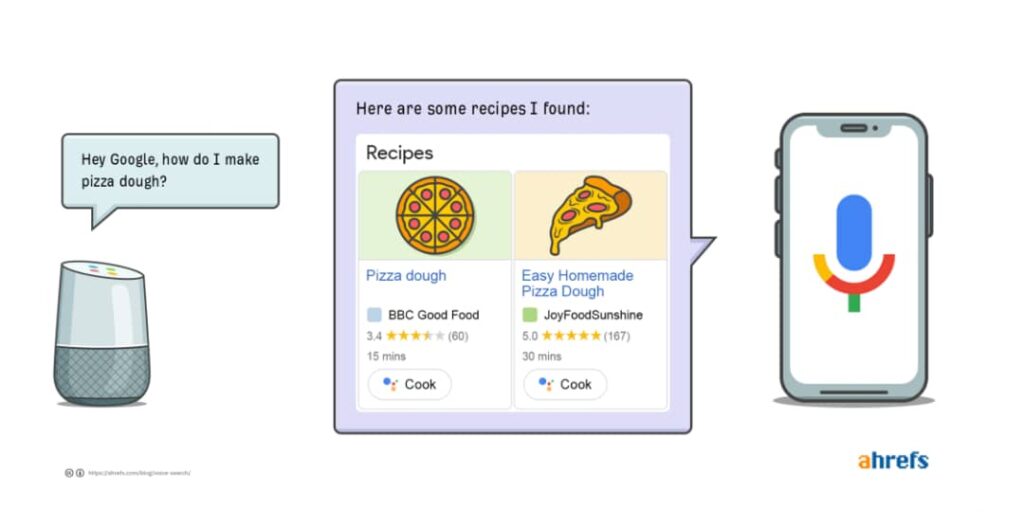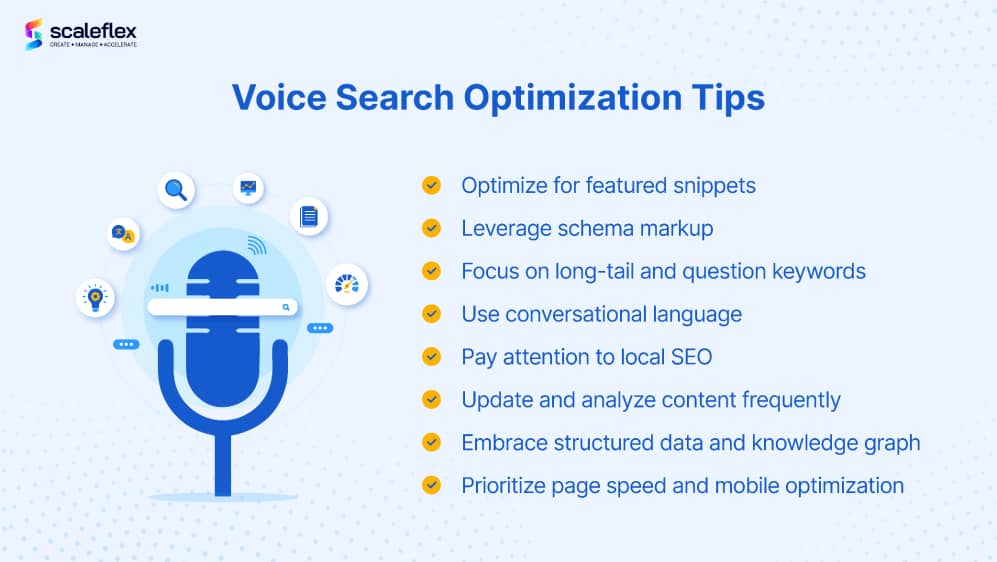
“Hey Google, how do I make pizza dough?”
You just asked your phone how to make something you want— now imagine your audience asking the same about your business. That’s voice search in action, and it’s no longer a novelty. With more users speaking to their devices instead of typing, voice search optimisation (VSO) is fast becoming a must-have skill for website owners and digital marketers.
Why should you care? Because voice queries are growing, and they behave differently from typed ones. They’re more conversational, context-driven, and often local. If your content isn’t prepared, you may miss out on a new channel of high-intent traffic.
In this guide, you’ll learn what voice search is, why it matters, how it works behind the scenes, what makes it different from traditional SEO, and—most importantly—how you can optimise your site step by step. By the end, you’ll have clear, actionable tactics you can implement right away.
What is Voice Search?
Voice search (sometimes called voice-enabled search) is simply a way for users to speak their queries into a device such as a smartphone, smart speaker, or virtual assistant, instead of typing them. The device’s speech recognition system turns spoken words into text, which is then processed by search engines or voice platforms.
Common examples include asking Siri on an iPhone, saying “Hey Google” on an Android or Google Home device, or speaking to Alexa on an Amazon Echo. These assistants let users perform searches, ask questions, control smart home devices, and more — all by voice.
To see how voice search differs from typing, compare:
- Typed query: “best pizza in Lagos”
- Voice query: “Hey Google, where is the best pizza place near me in Ikeja?”
Voice versions tend to be more complete sentences or questions, often with local or immediate context. Users typically use voice when their hands or eyes are busy – for example, while driving, cooking, or walking. They seek fast, precise answers for immediate needs.
Voice search is particularly powerful for small tasks, like checking business hours, finding local services, asking “how-to” questions, or performing quick fact checks. Because it often surfaces a single result (or reads a short answer), your content must be ready to be understood and “spoken back” by devices.
Why Voice Search Matters Today
Voice search matters now, not in some distant future! As device adoption increases — smart speakers, wearables, voice assistants embedded in phones and TVs — more people are discovering the convenience of speaking rather than typing. Here’s why it’s relevant for you:
- High user intent: Many voice queries are local or transactional (e.g. “Where’s the nearest bakery?”). These users often have purchase or visit intent, which makes them valuable.
- Voice-first ranking is competitive: Because voice assistants often read a single answer (rather than listing many links), there’s a premium on being the chosen answer.
- Better user experience & accessibility: Voice aids users with mobility or vision constraints, and people generally prefer quick, conversational interactions to cumbersome search forms.
- Spillover benefits for SEO: Optimising for voice often improves page speed, mobile usability, structured data, and content clarity. These are all good for traditional SEO as well.
In short, voice search is changing how people look for information, and aligning your site to this shift gives you a competitive edge in visibility and conversions.
How Voice Search Works
To optimise for voice, you don’t need to be a technologist, but understanding the process helps you know what you’re competing with. Here’s a simplified pipeline:
- Speech recognition: The device listens to your spoken query and uses audio-to-text models (ASR — automatic speech recognition) to transcribe words. The system handles accents, background noise, and mispronunciations.
- Natural language understanding & intent detection: The system parses the text, detects user intent such as “find pizza”, “define voice SEO”, and grabs context such as location, device, and previous queries.
- Search & answer retrieval: The engine uses algorithms and search index data to find the best matching answer. Because voice assistants don’t show long lists, they often favour featured snippets, knowledge graphs, and structured data results.
- Response formatting & delivery: For screenless devices (smart speakers), the assistant will speak the selected answer. For devices with a display, it may both speak and display the answer.
Because voice assistants favour clear, succinct answers, your content must be structured to answer questions directly, use schema markup to help the engine interpret your page, and be fast and mobile-friendly so the assistant can fetch and present your results quickly.
Key Differences Between Voice SEO vs. Traditional SEO
Optimising for voice search is not just another SEO tweak; it requires some strategic shifts. Below are the key differences to keep in mind:
- Query length & phrasing: Typed searches tend to be short, keyword-dense (e.g. “SEO tools”). Voice searches are more natural and conversational (e.g. “What are the best SEO tools for small websites?”). Voice queries often include question words like who, what, where, when, why, and how.
- Search intent: Voice searches lean heavily into local, transactional, or informational queries with clear intent. Users often want immediate actions, such as directions, a phone call, hours, and definitions, rather than general browsing.
- SERP format & result type: Traditional SEO aims for a high ranking in a list of links. Voice assistants, however, tend to pick one answer often from a featured snippet, knowledge panel, or structured snippet. If your page is not the top concise candidate, it might not be read aloud.
- Device & context constraints: Voice searches often happen on mobile or hands-free devices (smartphones, smart speakers), so factors like page speed, mobile responsiveness, and low latency are more critical. The context (e.g. user on the move, local search) matters more.
- Importance of featured snippets & structured data: Since voice assistants often pull from snippets or schema-based content, being optimised for position zero (with short answer blocks, FAQ markup, HowTo schema) is more important than ever.
These shifts mean that simply sprinkling in keywords won’t cut it. Your content must sound like a conversation, answer questions directly, be fast, and have structured markup that feeds into voice assistant workflows.
Practical Steps to Optimise for Voice

Here’s where we move from theory to execution. Below are four sub-steps to make your content voice-search ready.
Keyword Research for Voice
Start by thinking about questions. Use the 5 Ws and How (who, what, where, when, why, how) to brainstorm. Transform core keywords into conversational queries. For example, “car repair Lagos” becomes “Where can I get car repair near me in Lagos?” or “How much does car repair cost in Ikeja?”
Tap into Google Search Console to see queries users already use. Check the “Questions” section or filter for question-style queries. Also, use “People Also Ask” boxes on Google to discover what related questions people ask.
Focus on longer tail, low-to-medium volume but high relevance conversational variants. These often have less competition. Use those as the basis for your content.
Content & Structure for Voice
Adopt an FAQ-driven structure. Use H2 or H3 headings phrased as questions (e.g. “How do I optimise my site for voice search?”) and place the concise answer (usually in 40–50 words) immediately under the question heading. Many guides advise that short, direct answers increase your chances of being used as a spoken result.
Use natural language, active voice, and synonyms. Avoid jargon. Simulate how a person would ask, not how you’d type. Use bullet lists for “steps” or “tips” format questions. Include conversational transitions like “Here’s how…” “Let’s break it down”, to mirror human speech patterns. Keep paragraphs short. Use simple pronouns (you, your) and everyday language.
Technical Setup & Markup
Implement FAQ or HowTo schema markup (JSON-LD) in the head of pages or sections. This helps search engines understand which parts are questions or answers. It may boost the chance of being pulled for a voice answer.
Ensure fast page loads by minimising CSS/JS bloat and compressing images, using mobile-first design, and leveraging caching/CDNs. Use secure HTTPS. Also, optimise meta titles and descriptions clearly (they can help in discoverability, even if the voice reads the snippet).
Local & Mobile Specifics
Many voice searches are local, so claim and optimise your Google Business Profile. Make sure your NAP (Name, Address, Phone) is consistent across sites and directories. Build localised FAQ pages or landing pages with conversational local queries (“What’s a good bakery near Surulere?”). Use region-specific wording, slang, and landmarks. Ensure your site functions well on mobile because many voice requests come from phones.
Common Mistakes & How to Avoid Them
Here are frequent pitfalls beginners make and how to dodge them:
- Taking too long before the answer — bury the answer deep down. Voice assistants prefer quick, direct responses.
- Ignoring mobile speed & performance — a slow site kills chances of being fetched quickly.
- Exact-match overuse — over-optimising for rigid keyword forms rather than natural phrasing weakens content.
- Skipping schema markup & structured data — without it, assistants may not interpret your content as Q&A.
- Not testing real voice queries — you need to see what gets spoken. Use your phone or smart speaker to test target questions.
Fixing these ensures your voice-search efforts don’t get trapped in common traps.
Measuring Success & Tools to Use
To see if your voice optimisations are working, focus on these metrics:
- Impressions of question-style queries in Search Console (filter queries with “how”, “what”, etc.).
- Clicks and CTR for pages optimised for voice.
- Featured snippet/ranking changes — did your target questions move into position zero?
- Local traffic & phone calls — did your “near me” pages generate more calls or visits?
- Voice assistant testing — record what your phone / smart speaker returns for your queries over time.
Useful (mostly free) tools include:
- Google Search Console for query data, impressions, and CTR.
- Page speed tools such as Lighthouse and PageSpeed Insights for technical audits.
- Analytics event tracking to tag voice-triggered conversions.
- Local listing checkers/citation tools to ensure your NAP is consistent across directories.
Regular testing on real devices is key, so ask your phone your own questions and see what’s returned.
Conclusion
Voice search is already shaping how people discover information, especially on mobile and smart devices. To get ahead, you must shift your mindset from typed keywords to conversational queries, from long blocks of content to succinct Q&A snippets, and from basic pages to structured, schema-ready sections.
Start small. Pick one topic, map out 5–10 question keywords, build an FAQ page with short answers, apply FAQ schema, test it via your phone, and monitor performance. Over time, replicate the process across your key verticals.